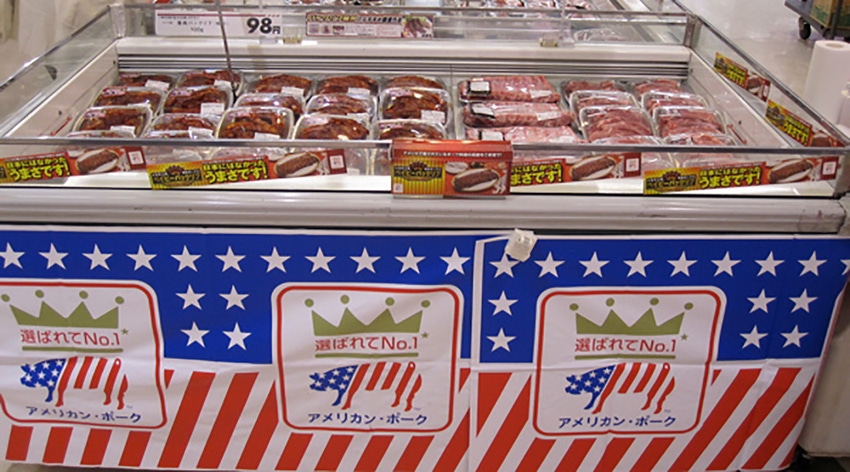Japanese are eager to get U.S. red meat on level playing field
Dave Preisler, Minnesota Pork Board CEO, says one of the areas that impressed him most is the contacts USMEF has already established throughout Japan.

It’s been less than two weeks since President Donald Trump and Japanese Prime Minister Shinzo Abe announced a trade agreement that will, once implemented, put U.S. red meat back on a level playing field with international competitors, but enthusiasm is already building across the largest value destination for U.S. pork and beef exports. That’s the consensus from a U.S. Meat Export Federation-led Heartland team touring Japan this week to see funding dollars at work.
“There’s a lot of enthusiasm with the trade, with the customers in Japan about that,” says Dan Halstrom, USMEF president and CEO. “We are operating at a disadvantage at the moment, with a 12% duty disadvantage for the U.S. versus some of our key competitors like Australia, Canada and Mexico and also we’re at a disadvantage on the pork side with seasoned ground pork at about a 7% duty disadvantage, as well as the processed meats. We’re happy to say that the trade here in Japan is very enthusiastic about the prospect of getting on a level playing field sooner rather than later. I would say the timing of our trip in regard to that was perfect.”
Dean Meyer, Iowa Corn Growers Association director and USMEF Executive Committee member, echoed Halstrom’s comments. The northwest Iowa corn, soybean, cattle and hog farmer says U.S. corn is committed to partnering with the livestock brands in exporting red meat and it was good to see the excitement for that from the buyers and retailers.
“One thing that has impressed me is being able to go into the retail and they had specific pork promotions where they partnered with corn and soybean checkoff dollars to promote, not grain-fed, but U.S. corn and soybean-fed, and I believe that they’re going to promote beef in the same way,” Meyer says. “Just to see how it’s promoted there and the consumer — their excitement about eating the corn-fed U.S. pork and beef.”
Dave Preisler, Minnesota Pork Board CEO, says one of the areas that impressed him most is the contacts USMEF has already established throughout Japan.
“Business isn’t done country to country; business is done person to person and from business to business, and without those sorts of contacts, business doesn’t happen,” Preisler says. “Countries can set the trading rules, but it’s really people that actually make the deals happen, and I think that when you look at investment in checkoff dollars, especially in the U.S. Meat Export Federation, their goal is to grow the entire meat sector, not just to grow one specific packer’s brand. It is to grow the entire consumption of beef, pork and lamb and that’s why we really appreciate their work.”
Dermot Hayes, an economist at Iowa State University, estimates exports to Japan will grow from $1.6 billion in 2018 to more than $2.2 billion over the next 15 years as a result of the U.S. pork industry getting market access in Japan as favorable as its competitors. With those potential figures in mind, Preisler says another takeaway for him was the overall impact the trade agreement could have on rural communities in the Midwest.
“Over half the calories in Japan are imported and that’s not going to change, in fact that number may even become more and why not have that come from, in our case, the Upper Midwest in the form of red meat,” Preisler says. “They’ve got a tremendous demand for it plus we know that we can supply the volume and quality they are demanding. In the end, what that does is take dollars from in this case, Japan, back into rural communities, whether they’re in rural Iowa and Nebraska or South Dakota and Minnesota, and that makes a difference as we try to have vibrant little communities in the Upper Midwest.”
While Preisler says he didn’t see much bacon on the shelves, there’s a tremendous amount of thin-sliced loin in the country’s meat cases and it was good to see the United States is meeting those specific consumer pork preferences. Japanese buyers and retailers were also interested in hearing more about quality assurance programs on both the pork and beef side and how that impacts the overall quality of the product.
Finally, Preisler says the trip provided a good opportunity to address supply concerns surrounding the recent global African swine fever outbreaks.
“Just the dynamics of where demand may come from, where supplies are going to come from and also discussions over what we’re doing in the United States to first and foremost keep the virus out of the U.S. so that we can maintain that status of being a reliable supplier,” Preisler says.
About the Author(s)
You May Also Like





